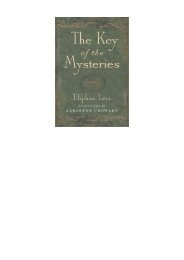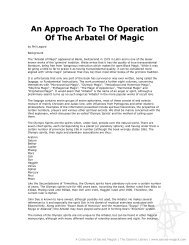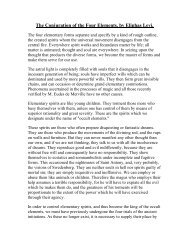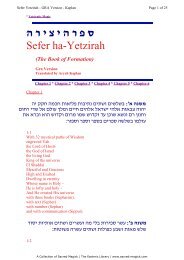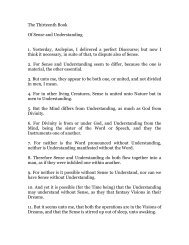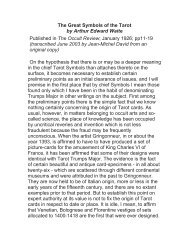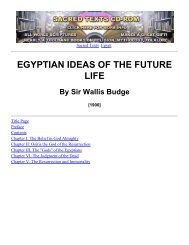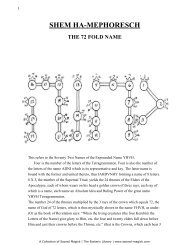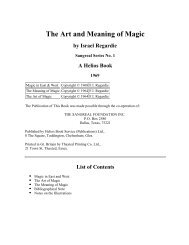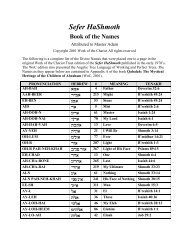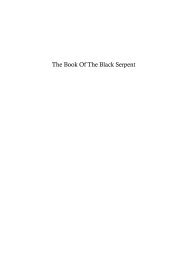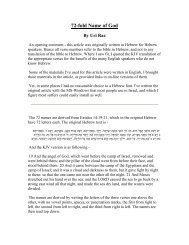The Sepher Yetzirah
The Sepher Yetzirah
The Sepher Yetzirah
You also want an ePaper? Increase the reach of your titles
YUMPU automatically turns print PDFs into web optimized ePapers that Google loves.
imagination of commentators have gathered around it, will be dissipated, if<br />
we look for, in it, not mysteries of ineffable wisdom, but an attempt at a<br />
reasonable doctrine, made when reason arose, an effort to grasp the plan of<br />
the universe, and to secure the link which binds to one common principle,<br />
all the elements which are around us."<br />
"<strong>The</strong> last word of this system is the substitution of the absolute divine Unity<br />
for every idea of Dualism, for that pagan philosophy which saw in matter an<br />
eternal substance whose laws were not in accord with Divine Will; and for<br />
the Biblical doctrine, which by its idea of Creation, postulates two things,<br />
the Universe and God, as two substances absolutely distinct one from the<br />
other.<br />
"In fact, in the '<strong>Sepher</strong> <strong>Yetzirah</strong>,' God considered as the Infinite and<br />
consequently the indefinable Being, extended throughout all things by his<br />
power and existence, is while above, yet not outside of numbers, sounds and<br />
letters--the principles and general laws which we recognise."<br />
"Every element has its source from a higher form, and all things have their<br />
common origin from the Word (Logos), the Holy Spirit…. So God is at once,<br />
in the highest sense, both the matter and the form of the universe. Yet He is<br />
not only that form; for nothing can or does exist outside of Himself; His<br />
substance is the foundation of all, and all things bear His imprint and are<br />
symbols of His intelligence."<br />
Hebrew tradition assigns the doctrines of the oldest portions of the "Zohar"<br />
to a date antecedent to the building of the Second Temple, but Rabbi<br />
Simeon ben Jochai, who lived in the reign of the Emperor Titus, A.D. 70-80,<br />
is considered to have been the first to commit these to writing, and Rabbi<br />
Moses de Leon, of Guadalaxara, in Spain, who died in 1305, certainly<br />
reproduced and published the "Zohar."<br />
Ginsburg, speaking of the Zoharic doctrines of the Ain Suph, says that they<br />
were unknown until the thirteenth century, but he does not deny the great<br />
antiquity of the "<strong>Sepher</strong> <strong>Yetzirah</strong>," in which it will be noticed the "Ain Suph<br />
Aur" and "Ain Suph" are not mentioned.I suggest, however, that this omission<br />
is no proof that the doctrines of "Ain Suph Aur" and "Ain Suph" did not then<br />
exist, because it is a reasonable supposition that the "<strong>Sepher</strong> <strong>Yetzirah</strong>" was<br />
the volume assigned to the Yetziratic World, the third of the four Kabalistic<br />
Worlds of Emanation, while the "Asch Metzareph" is concerned with the<br />
Assiatic, fourth, or lowest World of Shells, and is on the face of it an<br />
alchemical treatise; and again the "Siphra Dtzenioutha" may be fittingly<br />
considered to be an Aziluthic work, treating of the Emanations of Deity<br />
alone; and there was doubtless a fourth work assigned to the World of Briah-<br />
-the second type, but I have not been able to identify this treatise. Both the<br />
Babylonian and the Jerusalem Talmuds refer to the "<strong>Sepher</strong> <strong>Yetzirah</strong>." <strong>The</strong>ir<br />
treatise, named "Sanhedrin," certainly mentions the "Book of Formation,"<br />
and another similar work; and Rashi in his commentary on the treatise<br />
"Erubin," considers this a reliable historical notice.Other historical notices<br />
are those of Saadya Gaon, who died A.D. 940, and Judah Ha Levi, A.D. 1150;<br />
both these Hebrew classics speak of it as a very ancient work. Some modern<br />
critics have attributed the authorship to the Rabbi Akiba, who lived in the<br />
time of the Emperor Hadrian, A.D. 120, and lost his life in supporting the<br />
claims of Barchocheba, a false messiah: others suggest it was first written<br />
about A.D. 200.<br />
Graetz however assigns it to early Gnostic times, third or fourth century,<br />
and Zunz speaks of it as post Talmudical, and belonging to the Geonim<br />
period 700-800 A.D.; Rubinsohn, in the Bibliotheca Sacra, speaks of this<br />
latter idea as having no real basis.



